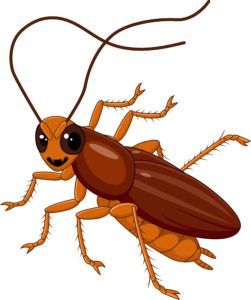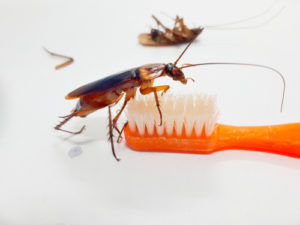LA CUCARACHA

THE COCKROACH – but who doesn’t know that?
The American cockroach that lurks in our kitchens and forages through our trash bins is about an inch long; it’s just one of thirty varieties that plague us. There’s also the creepy large version that lumbers about on longer legs throughout the South. Nearly mouse-size, they look possibly edible (if you’re desperate enough). Scary things, those.
And smart. There was one whose movement caught our eyes at the El Paso airport. He was scurrying intently across the terminal floor, skillfully avoiding large feet, aiming at the automatic door. Arriving at the exit, he paused to one side, seeming to wait for a human to activate his egress. We were fascinated. Someone came; he made his getaway. Clearly it was a process he’d used before.
 A droll ditty exists about the cockroach, the popular toe-tapping Mexican “La Cucaracha” (origin unknown), the critter that doesn’t get around because he’s out of marijuana. For an entertaining summary of its lyrics and history, click on:
A droll ditty exists about the cockroach, the popular toe-tapping Mexican “La Cucaracha” (origin unknown), the critter that doesn’t get around because he’s out of marijuana. For an entertaining summary of its lyrics and history, click on:
www.cecil@straightdope.com
The ubiquitous cockroach, brown insect of the 4,600-member order Blattodea, is a survivor of everything. He’s known to have existed through life-threatening perils for 350 million years. The insect shifts its venue at will, living on dribs and drabs of anything. The cockroach has been known to lodge in furniture, even in a clock, and thereby change its residence with a cross-country move. They’ve been known to hitch a ride all the way from New York (big center of infestations) to a new dwelling thousands of miles away. The unsuspecting homeowner dreamed of being rid of them, to have left them behind in his now abandoned dwelling. Silly twit. If the cockroach can live for years behind wallpaper, what’s a clock to conquer? Its life, though threatened in today’s world by countless poisons, continues undiminished.
It knows only to scour for food – and propagate. Which it does abundantly. At night, mostly, furtively scuttling in dark places to nosh and poop, leaving behind its e. coli and/or salmonella tainted feces. Oh – and dysentery, among countless other contagion. Even dusty dried up cockroach poo can cause annoying issues, like asthma and allergies. It has no social bias. It burrows in slums on neglected garbage; it lives in kitchen cabinets of elegant homes in upscale neighborhoods.
Once years ago, at a League of Women Voters meeting in the most upscale town outside of Boston, I was asked to please look for coffee sugar in our leader’s kitchen cabinet. Dutifully I went to the kitchen, opened a cabinet, throwing light suddenly onto open boxes, marmalade jars and cans – and an alarming, writhing blanket of small brown cockroaches, their antennae waving inside those gaping cereal boxes.
I shuddered, closed the cabinet door, returned empty-handed to the living room, and avoided my hostess’ inquiring eyes.
Faces turned towards me. I announced to the group that she was out of sugar.
Our cockroaches? In Alamos Mexico, our home is free of them. Mirabile dictu. If you are anti-pesticide, I hang my head in quasi shame. But they are rife there, especially that big black tropical one – and it’s them or us.
In drier Tucson, the moisture-seeking insect tries to access our house through drain pipes, an age-old sneak, probably since the advent of lead pipes in ancient Rome. We foiled that by putting borax in drains, a desiccating and poisonous item for them; they collect and carry the powder away on their little hairy leg bristles where ultimately it dispatches them.
That works.

As always, an interesting musing on one of fellow earth inhabitants! I agree with your Alamos viewpoint – it’s them or us. Cheers, Peg